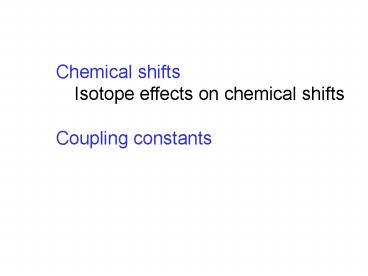Chemical shifts - PowerPoint PPT Presentation
1 / 35
Title:
Chemical shifts
Description:
paramagnetic effects. unpaired electrons. metal ions. solvent effects. isotope effects ... Two major mechanisms for paramagnetic shifts. The chemical shift time scale ... – PowerPoint PPT presentation
Number of Views:683
Avg rating:3.0/5.0
Title: Chemical shifts
1
Chemical shifts Isotope effects on chemical
shifts Coupling constants
2
Software to check out
Software for turning coordinates (in
PDB format) into chemical shifts
Mike Williamson's lab (Sheffield)
http//www.shef.ac.uk/uni/projects/n
mr/resources.html David
Case's lab (Scripps)
http//www.scripps.edu/case/casegroup.html Softwa
re for predicting chemical shifts from amino acid
sequence SHIFTY program from
David Wishart
http//www.bmrb.wisc.edu8999/shifty.html Softwar
e for determining 2 structure (phi, psi values)
from chemical shifts TALOS
program from Delaglio and Bax
http//spin.niddk.nih.gov/bax/software/TALOS/
info.html
3
Chemical shift basics
Chemical shift tensor averaged in solution
(provides relaxation mech.) Origin of
shifts diamagnetic effects electron density ring
current effects paramagnetic effects unpaired
electrons metal ions solvent effects isotope
effects
4
Chemical shift anisotropy
circulating electrons produce a diamagnetic field
which is orientation dependent
chemical shielding tensors
5
Ring current contributions to chemical shifts
Johnson Bovey, 1962
6
Example of ring-current shifts
7
Two major mechanisms for paramagnetic shifts
8
The chemical shift time scale
9
(No Transcript)
10
Dependence of 13C? chemical shift on phi and psi
?? /ppm
?
?
Eric Oldfield
11
Isotope effects on chemical shifts
18O isotope effects are used widely in
mechanistic studies of enzymes 1?15N(16O/18O)
27 ppb (nitrile oxide)
56 ppb (nitrate)
138 ppb (nitrite)
159 ppb (isoxazole) 1?13C (16O/18O) 15
ppb (primary alcohols)
54 ppb (ketones) effects are additive/atom
substituted Risley Van Etten, Methods Enzymol.
177376 (1989)
12
(No Transcript)
13
(No Transcript)
14
Isotope effects on chemical shifts (continued)
18O isotope effects in phosphates (pioneered by
Mildred Cohn) 0.02 ppm upfield shift/ 16O
?18O substitution Villifranca, Methods Enzymol.
177390 (1989)
15
(No Transcript)
16
Magnitudes of isotope effects on substituting
backbone N-H with N-D
1-bond 1?15N(H/D) 600
ppb 2-bond 2?13C? N(H/D) 80
ppb 2?13C? N(H/D) 110-150 ppb 3-bond 3?13C ?
N(H/D) lt 30 ppb 3?13C ? N(H/D) lt
30 ppb All shifts are toward lower frequency on
substituting the lighter isotope (H) with the
heavier (D)
17
Problems presented by isotope effects on chemical
shifts
Chemical shifts determined in H2O dont match
those in H2O Solution apply correction factors
Fractional deuteration leads to multiple
peaks No easy solution
18
Additional information provided by isotope
effects on chemical shifts
Structural Isotope effects can report on torsion
angles Kinetic H/D exchange in 50 H20/D20
can be monitored by line shape
19
Isotope effects in proteins that yield structural
information
1-bond 1?15N(H/D) 1?13C? (H/D) 2-bond 2?13C?
N(H/D) 3-bond 3?13C? N(H/D) 3?13C? N(H/D)
P.E. Hansen, Magnetic Resonance in Chemistry.
38(1)1-10, 2000
20
Use of 3?13C? isotope effects to measure ?
?-helix ?-sheet
3?13C? /ppb
0 20 40
-180 -120 -60 0
60 120 180
? /deg
Sprangers et al., J. Biomol. NMR 16 47-58, 2000
21
Other options for measuring ?
J-couplings arent helpful 3J H?I Ni1 doesnt
specify ? uniquely 3J H?I Ni1 too small to be
practical 3J H?I Ni1 too small to be practical
empirical analysis of chemical
shifts database-derived energy
potentials combination of secondary shifts,
sequence homology, and PDB structures
22
Spin-spin coupling
23
Origin of multiplets
Interaction of H and D
Interaction of CH2 and CH3
24
Mechanism of spin-spin coupling
definition of the torsion angle ?
25
Karplus curve
26
3JHNH? couplings characteristic of secondary
structure
27
One-bond couplings exploited in 2D - 4D NMR
experiments
28
Experimental measurement of couplings
Evolution of approaches Double-quantum-filtered
COSY E-COSY 3D multinuclear versions of the
E-COSY idea Quantitative J-coupling experiments
29
(No Transcript)
30
(No Transcript)
31
(No Transcript)
32
(No Transcript)
33
(No Transcript)
34
(No Transcript)
35
(No Transcript)































